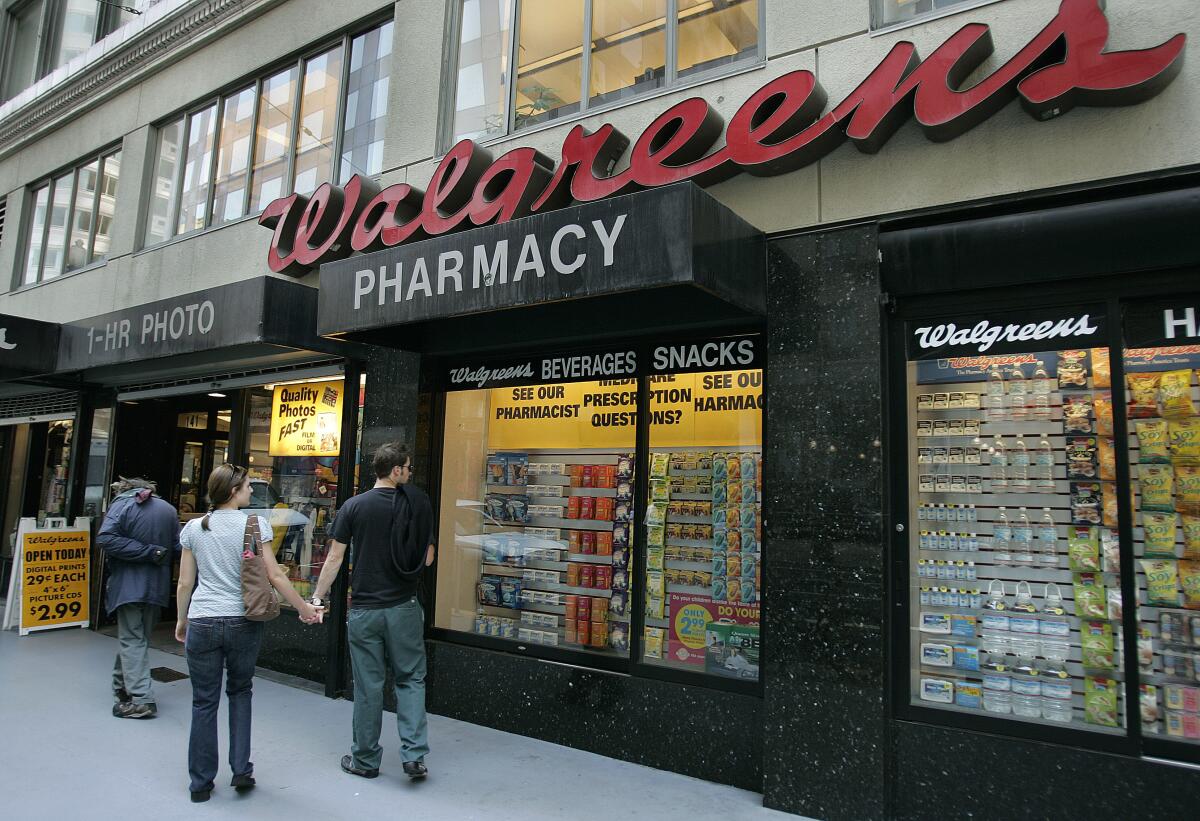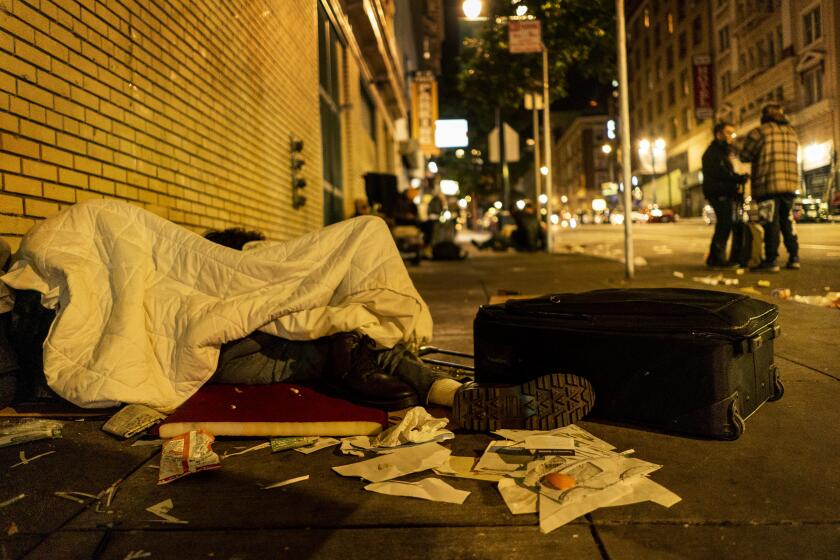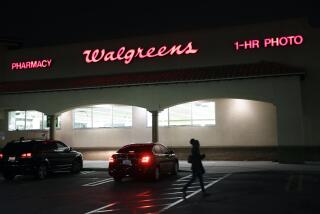Walgreens fueled San Francisco’s opioid epidemic with thousands of ‘suspicious orders,’ judge rules

A federal judge ruled Wednesday that pharmacy giant Walgreens could be held liable for fueling the opioid epidemic in San Francisco by shipping and dispensing hundreds of thousands of “suspicious orders” of prescription drugs, the latest legal reckoning over America’s prescription drug crisis.
More than 100 million prescription opioid pills were dispensed by Walgreens in the city between 2006 and 2020, and during that time, the pharmacy giant failed to investigate hundreds of thousands of orders deemed suspicious, U.S. District Judge Charles Breyer wrote in his 112-page opinion in a lawsuit filed by San Francisco against major prescription drug sellers.
“Walgreens has regulatory obligations to take reasonable steps to prevent the drugs from being diverted and harming the public,” Breyer wrote. “The evidence at trial established that Walgreens breached these obligations.”
The judge’s decision in the nonjury trial opens the door to a trial on the extent of the financial liability the company would face.
The public nuisance lawsuit, filed by the city in 2018, also included claims against Johnson & Johnson, Allergan, Purdue Pharma, Teva Pharmaceutical Industries and Endo International, as well as McKesson Corp., AmerisourceBergen Corp. and Cardinal Health — three of the biggest drug distributors in the country.
Interim San Francisco D.A. withdraws plea deals offered by Chesa Boudin in fentanyl-dealing cases, which could lead to increased incarceration rates.
Walgreens was the only company that didn’t reach a settlement with the city before the ruling. Johnson & Johnson and the three drug distributors were part of a $26-billion nationwide settlement earlier this year.
The opioid crisis has ravaged San Francisco in recent years. Emergency visits because of opioids have spiked from 886 in 2015 to 2,998 in 2020, according to court filings. In 2019, about 40,958 city residents out of about 860,000 San Franciscans suffered from opioid addiction. In 2019, about 1,939 city residents overdosed on opioids, averaging to about 5.3 overdoses a day.
Peter Mougey, one of the attorneys representing the city, said the verdict sheds a light on the negligence Walgreens displayed in failing to stop the opioid epidemic in San Francisco.
“The sun has set on Walgreens’ attempt to hide the evidence of its nonexistent opioid compliance program while it instead focused on profits by flooding San Francisco with a tsunami of pills,” he said.
The company expressed its disappointment with the decision and said it’s planning to appeal, according to Walgreens spokesperson Fraser Engerman.
“As we have said throughout this process, we never manufactured or marketed opioids, nor did we distribute them to the ‘pill mills’ and internet pharmacies that fueled this crisis,” he said in a statement.
Facilities where people can use drugs without repercussions remain illegal in California. San Francisco is running one anyway.
Daniel Ciccarone, a professor of addiction medicine at UC San Francisco, said that companies turning a blind eye to the oversupply of opioid prescriptions has led to the rise of heroin and fentanyl addiction by increasing the pool of people dependent or addicted to opioids.
“Most of them migrated to safety, but 4% to 6% of this population migrated over to heroin because they were no longer having their addiction or pain needs fulfilled through pills,” he said. “For a while, the pills were available on the street, but even that pill supply dried up and what you’re left with is plentiful heroin on American streets. For unclear reasons, fentanyl has been a substitute or a contaminant of the heroin supply and now we see the third wave of the opioid crisis, which is the historically unseen rise of overdose deaths due to fentanyl.”
Walgreens distributed prescription opioids to its San Francisco pharmacies until 2014 without investigating orders or maintaining “an effective system for identifying suspicious orders,” Breyer said. The U.S. Drug Enforcement Administration shut down one of the company’s three controlled substance distribution centers in 2012 because of the center’s failure to surveil suspicious orders. Walgreens stopped distributing controlled substances in 2014 and started outsourcing to third-party distributors.
Federal regulations require companies to investigate “red flag” prescriptions and verify that the opioid prescriptions are medically legitimate before dispensing them. Walgreens dispensed hundreds of thousands of “red flag” opioids without investigating them; tens of thousands of the prescriptions were “written by doctors with suspect prescribing patterns” and hundreds of thousands were written by doctors who would later have their licenses suspended or go to prison, according to Breyer’s ruling.
The company also didn’t give pharmacists enough staffing, time or resources to adequately review the prescriptions, Breyer wrote. Pharmacists said they endured “constant pressure to fill prescriptions as quickly as possible.”
Pharmacists testified that they were aware they dispensed opioid prescriptions that they knew shouldn’t have been filled. One said that after he filled a prescription at a San Francisco pharmacy, he saw it was being sold in the parking lot.
Breyer also ruled that Walgreens filled prescriptions from prescribers who were blocked from other pharmacy chains or were deemed suspicious. In one instance, after a Walgreens pharmacy in San Francisco refused to fill prescriptions for a “suspicious” doctor, other Walgreens pharmacies dispensed 86,904 opioid pills for his prescriptions.
The pharmacy giant reached a $683-million settlement earlier this year with the state of Florida over claims of dispensing millions of opioids that worsened the crisis.
In November, a federal jury in Ohio found that Walgreens, along with CVS and Walmart, recklessly distributed pills that resulted in hundreds of overdose deaths and cost two Ohio counties about $1 billion each.
Ciccarone said that he hopes the money obtained through the lawsuits and settlements will be used to help reduce the risk of opioid overdoses and provide resources for treatment.
“This is a crisis and there’s a huge, vulnerable population in need,” he added.
For those involved in addiction, the ruling felt like a victory, even for those without a direct connection to Walgreens.
Laurie Steves’ daughter Jessica DiDia lives on the streets of San Francisco and is addicted to fentanyl and crack cocaine. Steves said she drove from Tacoma, Wash., to San Francisco last summer to try to get DiDia to get clean, but to no avail.
“Her addiction is so bad that she actively seeks fentanyl every day,” Steves said. “She lost her partner to a fentanyl overdose about three months ago. I was hoping that would be a wake-up call for her but it wasn’t.”
Tom Wolf lived in a home in Daly City with his wife and two children and worked as a child support officer for the city. But in early 2015, he underwent foot surgery and was prescribed 10 milligrams of oxycodone by his doctor.
Wolf was given a 30-day supply but he started taking three pills at a time. When his supply ran out, he went through withdrawal and started buying drugs off the street in San Francisco until his wife gave him an ultimatum: Go to rehab or leave the house.
Wolf chose the drugs, living on the streets and getting arrested six times in 2018 before getting sober through a drug treatment program. Wolf said that when he was buying pills in San Francisco, his main dealer was getting oxycodone through legal prescriptions from the local Veterans Affairs hospital.
“That was the benchmark,” he said. “I took those 30 milligrams and I felt euphoria. Any marital or financial problems went away for three to four hours and I liked that feeling and I wanted to keep having that feeling.”
Having been sober for four years and reconciled with his family, Wolf said he was glad about the Walgreens ruling.
“It’s a double-edged sword,” Wolf said. “It’s 10 years too late but I’m glad they’re being held accountable. I’m also sad because that by overprescribing, they contributed to millions of Americans struggling with addiction and the rise of illicit fentanyl in this country.”
More to Read
Sign up for Essential California
The most important California stories and recommendations in your inbox every morning.
You may occasionally receive promotional content from the Los Angeles Times.













